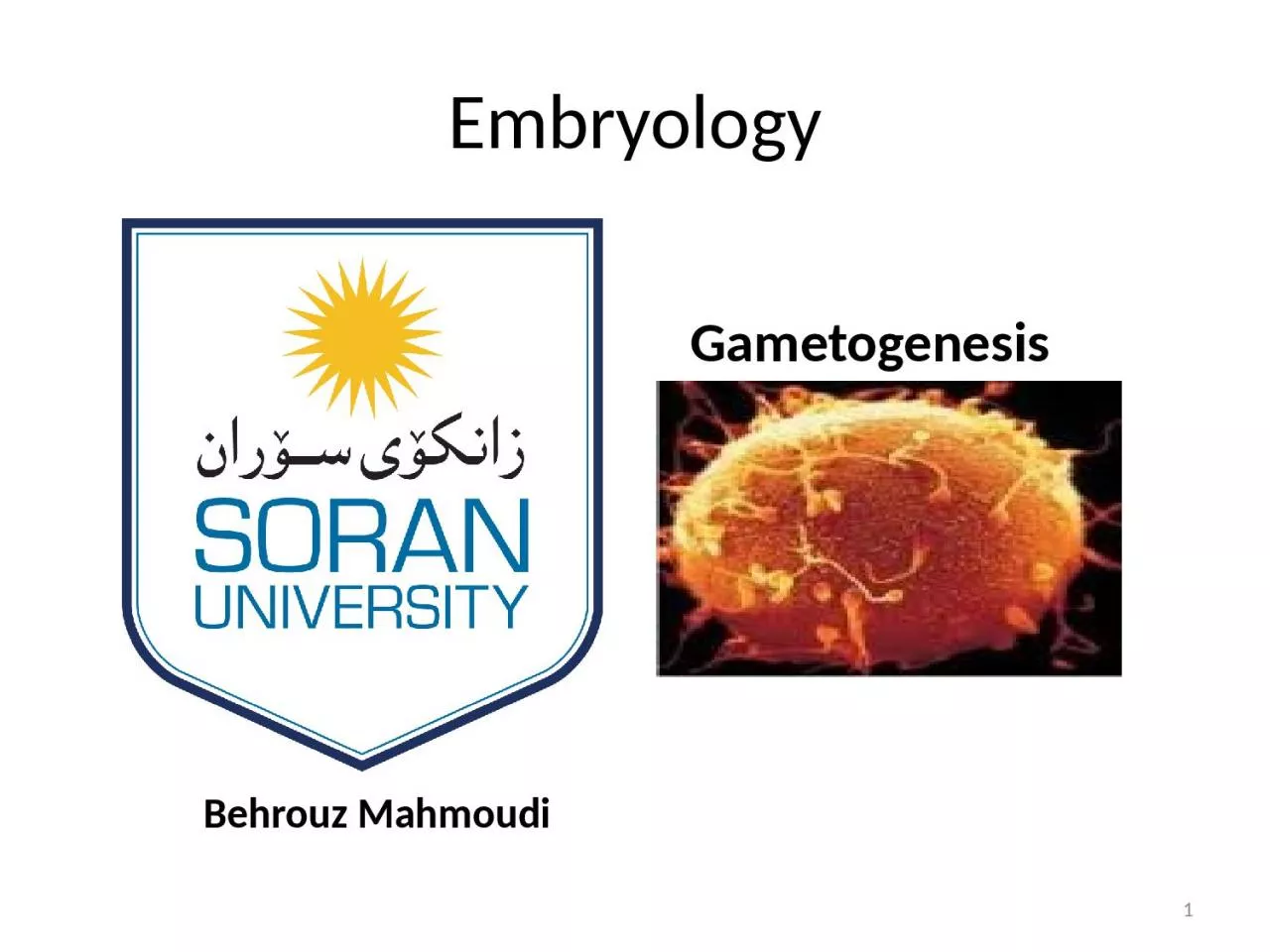

Gametogenesis 1 Gametogenesis is the creation of gametes Gametes derived from primordial germ cellsPGCs that are formed in the epiblast during the second week and that move to the cell wall of the yolk sac ID: 933406
Download Presentation The PPT/PDF document "Embryology Behrouz Mahmoudi" is the property of its rightful owner. Permission is granted to download and print the materials on this web site for personal, non-commercial use only, and to display it on your personal computer provided you do not modify the materials and that you retain all copyright notices contained in the materials. By downloading content from our website, you accept the terms of this agreement.
Slide1
Embryology
Behrouz Mahmoudi
Gametogenesis
1
Slide2Gametogenesis
is the creation of gametes.
Gametes
derived from primordial germ cells(PGCs) that are formed in the
epiblast
during the
second
week and that move to the cell wall of the yolk sac
In preparation for fertilization,
germ cells undergo gametogenesis, which includes meiosis, to reduce the number of chromosomes and cytodifferentiation to complete their maturation
MeiosisMeiosis is the cell division that takes place in the germ cells to generate male and female gametes
2
Slide33
Slide44
Slide5Crossover
Crossovers, critical events in meiosis I, are the
interchange of chromatid segments
between paired homologous chromosomes Segments of chromatids break and are exchanged as homologous chromosomes separate. As separation occurs, points of interchange are temporarily
united
and form an
X-like
structure, a chiasma. The approximately 30
to 40 crossovers (one or two per chromosome) with each meiotic I
division are most frequent between genes that are far apart on a chromosome.Genetic variability is enhanced through●crossover, which redistributes genetic material
●random distribution of homologous chromosomes to the daughter cells●Each
germ
cell contains a
haploid
number
of
chromosomes, so that at fertilization the
diploid
number of 46 is restored
5
Slide66
Slide7Oogenesis
Is the process whereby oogonia differentiate into mature
oocytes.Maturation of oocytes begins before
birth. Once PGCs have arrived in the gonad of a genetic female gonad they
differentiated
into
oogonia
. These cells by the end of the
third month they are arranged in clusters surrounded by a layer
of flat epithelial cells. All oogonia in a cluster are probably derived from a single cell, the flat epithelial cells known as follicular cells, originate from surface epithelium covering the ovary.
Follicular cell
Resting primary oocyte(
diplotene
stage)
Primary oocyte in prophase
Surface epithelium of ovary
Flat epithelial cell
O
ogonia
Primary oocytes in prophase of 1
st
meiotic division
Some of
oogonia
arrest their cell division in prophase of meiosis I and form primary
oocytes
7
Slide8Total number of germ cells by
fifth month of prenatal development, Es,
7 million.At this time, cell death
begins, many primary oocytes degenerate, become
atretic
.
By the
seventh month majority of
oogonia have degenerated except for a few near the surface.
All surviving primary oocytes have entered prophase of meiosis I, and most of them are individually surrounded by a layer of flat follicular epithelial cells.
A primary oocyte, together with its surrounding flat epithelial
cells
, is known as a
primordial
follicle.
Near
the time of
birth
,
all
primary
oocytes
have
started
prophase
of
meiosis
I,
but instead of proceeding into metaphase, they enter
the diplotene stage. This arrested state is produced by oocyte maturation inhibitor (OMI), a small peptide
secreted by follicular cells.8
Slide9The
total number of primary oocytes at birth
is estimated to vary from 600,000 to 800,000.
Approximately 40,000 are present by the beginning
of
puberty
, fewer than 500 will be Ovulated
.Each
month, 15 to 20 follicles selected from this pool begin to mature. Some of these die, while others begin to accumulate fluid in a space called the antrum, thereby entering the
antral or vesicular stage( A).
Theca
intrrna
Theca
externa
Antrum
Cumulus
oophorus
Primary oocyte
Follicular antrum
Zona
pelluida
A
B
immediately
prior
to
ovulation
,
follicles
are
quite
swollen
and are called
mature
vesicular
Follicles
or
Graffian
follicles(B
)
9
Slide10As
primordial follicles begin to grow, surrounding
follicular cells change from flat
to cuboidal and proliferate to produce a stratified
epithelium
of
granulosa
cells, and the unit is called a primary
follicle.Granulosa cells rest on a basement membrane separating them from surrounding ovarian connective tissue (stromal cells) that form the theca
folliculi.Granulosa cells and the oocyte secrete a layer of glycoproteins on the surface
of the oocyte, forming the zona pellucida
As development continues,
fluid-filled
spaces
appear
between
granulosa
cells.
Coalescence
of
these
spaces
forms the
antrum
, and
the
follicle
is termed a vesicular or an antral
follicle.Granulosa cells surrounding the oocyte
remain intact and form the cumulus oophorus.
10
Slide11With
each ovarian cycle, a number of follicles begin
to develop, but usually only one
reaches full maturity. The others degenerate
and become
atretic
.
When
the secondary follicle is mature, a surge
in luteinizing hormone (LH) induces the preovulatory growth phase. Meiosis I is completed, resulting in formation of two daughter cells of unequal size, each with 23 double-structured
chromosomes
Granulosa
cells
Secondary oocyte in division
Polar body in division
Secondary oocyte and polar body
1
Zona
pellucida
Primary oocyte in division
A
B
C
A.Primary
oocyte showing the spindle of the fi
rst
meiotic
division
B.Secondary
oocyte
and fi
rst
polar body. The nuclear membrane is absent
.
C.Secondary
oocyte showing the spindle of the second
meiotic
division. The
first
polar body is also dividing
11
Slide12One cell, the
secondary oocyte, receives most of the cytoplasm;
the other, the first polar body, receives practically none. The
first polar body lies between the
zona
pellucida
and the cell membrane of the secondary oocyte
in the perivite lline space. The
cell then enters meiosis II but arrests in metaphase approximately 3 hours before ovulation. Meiosis II is completed only if the oocyte is fertilized; otherwise
, the cell degenerates approximately 24 hours after ovulation. The first polar body may undergo
a second division
12